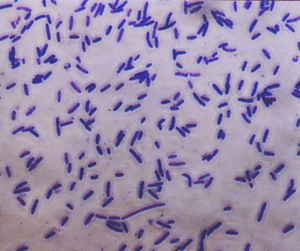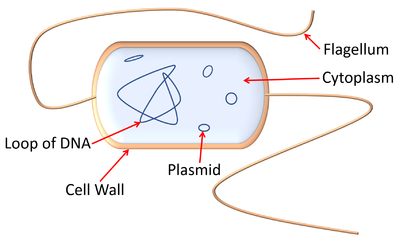Difference between revisions of "Bacteria"
(→About Bacteria) |
|||
| Line 21: | Line 21: | ||
|} | |} | ||
| − | ==Key Stage | + | ==Key Stage 4== |
===Meaning=== | ===Meaning=== | ||
[[Bacteria]] are [[unicellular]] [[Prokaryotic Cell|prokaryotes]] (with no [[membrane]] bound [[organelle]]s). | [[Bacteria]] are [[unicellular]] [[Prokaryotic Cell|prokaryotes]] (with no [[membrane]] bound [[organelle]]s). | ||
===About Bacteria=== | ===About Bacteria=== | ||
| − | : [[Bacteria]] can cause disease but some are important to keep us | + | : [[Bacteria]] can cause [[disease]] but some are important to keep us [[health]]y. |
| + | : [[Disease]] causing [[bacteria]] are known as [[Pathogenic Bacteria|pathogenic bacteria]]. | ||
: Some [[bacteria]] have a tail called a [[flagellum]] propel it move through [[water]]. | : Some [[bacteria]] have a tail called a [[flagellum]] propel it move through [[water]]. | ||
: Some [[bacteria]] are encased in a [[Slime Capsule|slime capsule]] which protects them from [[phagocyte]]s and some [[toxic]] [[chemical]]s. | : Some [[bacteria]] are encased in a [[Slime Capsule|slime capsule]] which protects them from [[phagocyte]]s and some [[toxic]] [[chemical]]s. | ||
: [[Bacteria]] do not have a [[Cell Nucleus|nucleus]]. | : [[Bacteria]] do not have a [[Cell Nucleus|nucleus]]. | ||
: The [[DNA]] of [[bacteria]] is in a loop. There are also smaller rings of [[DNA]] called [[plasmid]]s. | : The [[DNA]] of [[bacteria]] is in a loop. There are also smaller rings of [[DNA]] called [[plasmid]]s. | ||
Revision as of 22:58, 9 November 2018
Key Stage 3
Meaning

A magnified image of several bacteria.
Bacteria are unicellular micro-organisms that have no nucleus, mitochondria or chloroplast but do have cytoplasm, a cell membrane and a cell wall.
About Bacteria
- Bacteria can cause disease but some are important to keep us healthy.
- Some bacteria have a tail called a flagellum.
- Bacteria do not have a nucleus.
- The DNA of bacteria is in a loop. There are also smaller rings of DNA called plasmids.
| A diagram showing the features of a bacterium. |
Key Stage 4
Meaning
Bacteria are unicellular prokaryotes (with no membrane bound organelles).
About Bacteria
- Bacteria can cause disease but some are important to keep us healthy.
- Disease causing bacteria are known as pathogenic bacteria.
- Some bacteria have a tail called a flagellum propel it move through water.
- Some bacteria are encased in a slime capsule which protects them from phagocytes and some toxic chemicals.
- Bacteria do not have a nucleus.
- The DNA of bacteria is in a loop. There are also smaller rings of DNA called plasmids.
